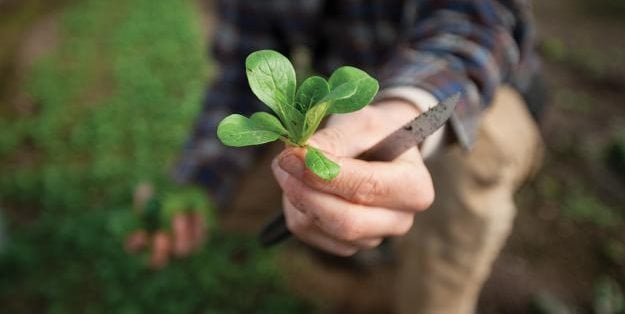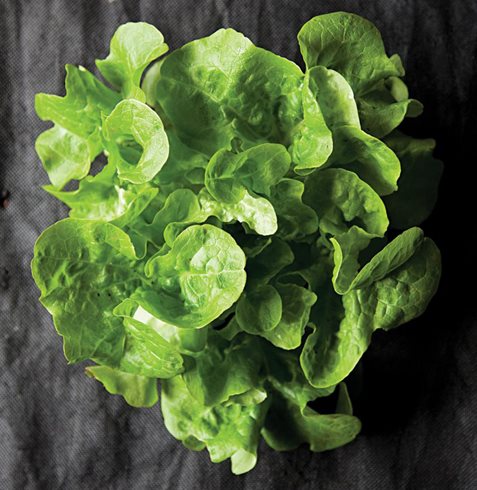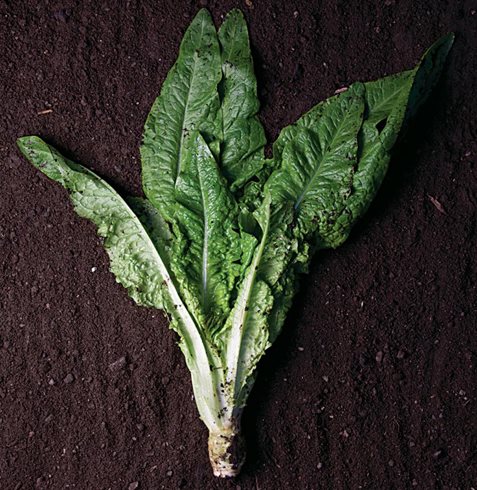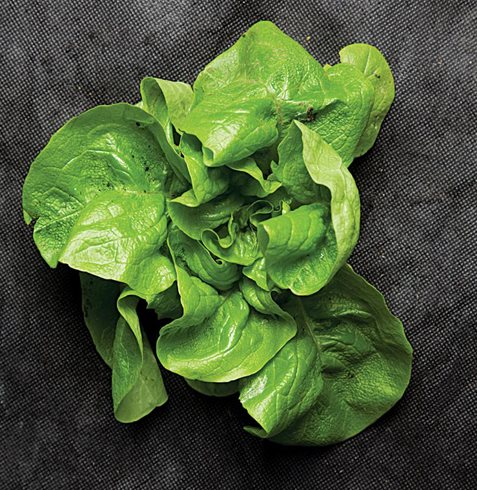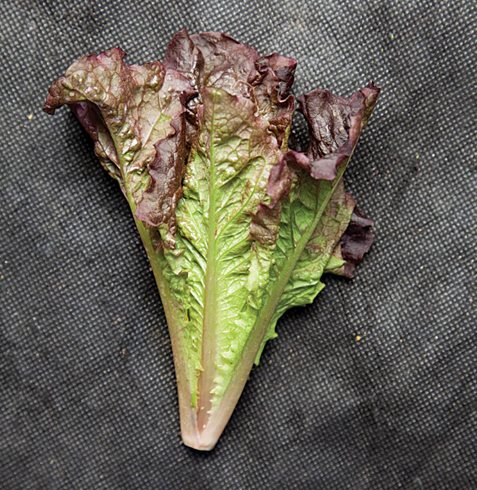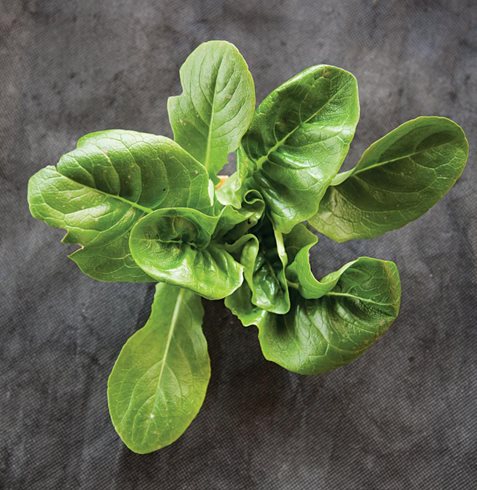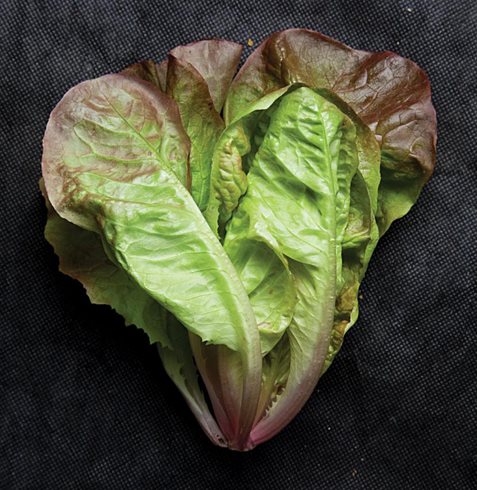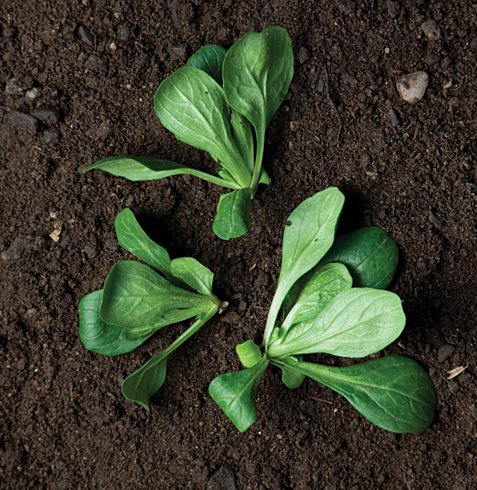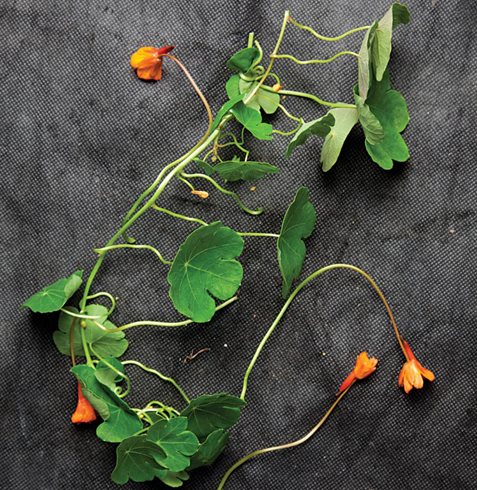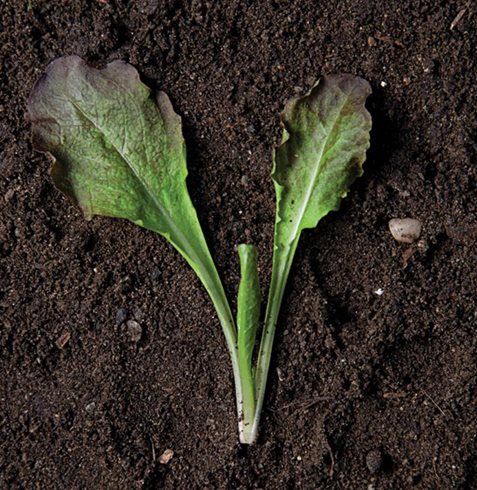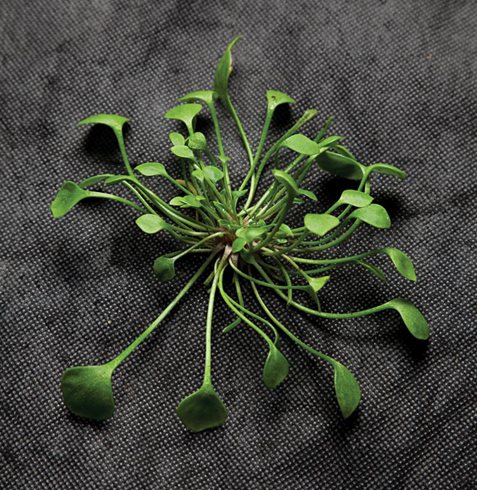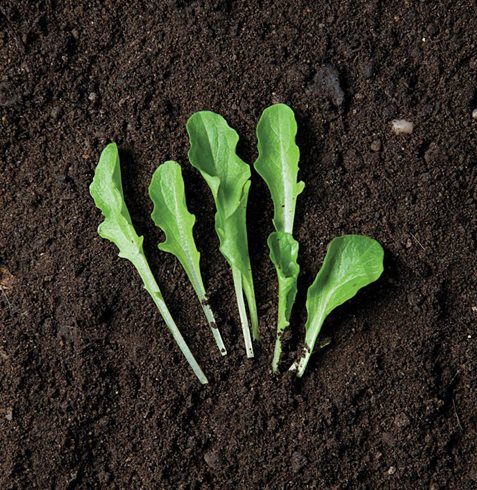Spring Greens
As any kitchen gardener knows, you can't beat a salad made of greens picked the same daySpring greens—mustard, miner's lettuce, radish—grow wild in the orchards on my Sacramento Valley farm. They're not indigenous to this part of California, but efforts at breeding greens have been so halfhearted that the cultivated forms hardly differ from their wild ancestors, and will happily go to seed and establish new populations in any congenial place. Dandelions (an excellent, bitter green) thrive in everyone's lawn; chicory grows in any crack in the pavement. If you have an enthusiasm for spring greens, as I certainly do, it may lead you to regress from horticulture to hunting and gathering.
One reason that greens adapt so easily is that they are native to my climate. The garden crops that we grow in summer—melons, tomatoes, aubergines—are tropical plants that we deceive into thinking they're at home by starting them in a warm season; they will collapse with the first frost, leaving no offspring. Greens, on the other hand, are of boreal origins. They enjoy a frost, even a dusting of snow, which allows them to be the earliest crops to come in. And the colder it is, the better the flavor. Botanically, most spring greens are from three plant families: the beet family (beet, chard, and spinach); the mustard family (kale, mustard, collard, and Asian brassica like mizuna and Chinese cabbage); and the lettuce family (dandelion, endive, escarole, lettuce). Mustard greens tend toward pungency, and lettuces toward bitterness, especially in hot weather.

Are you interested in growing lettuce in your garden? Here are five of our favorite catalogs for lettuce seeds:
Johnny's Selected Seeds: 11 pages of lettuces (877/564-6697).
Territorial Seed Company: More than 15 varieties of loose-leaf lettuce alone (800/626-0866).
Seed Savers Exchnage: A collection culled from lettuce trials that tested thousands of varieties (563/382-5990).
Burpee Gardening: Who knew there was an heirloom iceberg? (800/888-1447).
Seeds of Change: Ten new varieties of lettuce from a company committed to sustainable organic agriculture (888/762-7333).
Compiled by Alex Erikson.
Somehow, greens have escaped the efforts of plant breeders to increase their sugar content. Genetically modifying sugar content has been a cornerstone in the breeding of other plants (apples, grapes, carrots, beets, corn, yams, and onions) so that many of the varieties we grow today are far sweeter than those of 40 years ago. But spring greens are still virtuously unsweetened. Instead, what the plant breeders have been up to with greens is playing with their appearance.
My seed catalogues, collectively, list more than 100 varieties of lettuce, and reading through the descriptions I find no mention of flavor. They all taste the same.
Lettuce breeding is all about color and form. The loose-leaf lettuces in particular have wonderful leaf shapes. Some appear to have been designed by Picasso, others by Matisse. The same situation is found with many of the Asian brassicas—a profusion of shapes and a spectrum of colors, but only one flavor.
The flavor of lettuce, insofar as it has one, is subtle and elusive. In a salad, it is overpowered by the lemon or balsamic vinegar with its sharp, clear note (the violin), and the olive oil with its deep reverberations (the cello). Lettuce has the muted and conciliatory voice of a viola, so understated as to be hardly noticed. Its role in the salad is to provide texture and color. And the point of all those varieties is to satisfy the eye rather than the palate. Some cooks like a heavier orchestration than this in a spring salad, and they add arugula and scallions and nasturtium (piccolos, trumpets, cymbals).
As you might expect from their tendency to become weeds, greens are among the easiest of garden crops to grow. Scatter some seeds, wave a rake in their general direction, and you're on your way. And yet, to produce a pristine head of lettuce, or an unravaged rosette of mizuna, is a challenge.
The problem is that many creatures—aphids and caterpillars, snails and beetles, rabbits and mice, sparrows and quail—have an insatiable appetite for them. And so the leaves get ragged edges and become sprinkled with holes. In the field, a head of romaine or cabbage is a large plant, but the chewed-up outer half is shucked off and thrown away, and only the undamaged inner parts are sent to market.
One solution to the problem of predation is to sow the seed thickly and then harvest the plants very early, when they have made only one or two leaves, and before the creatures have got into them.

Once you've grown your salad greens, you'll want to make a salad with freshly picked leaves. Here are four of our favorite vinaigrettes from Saveur.com:
Sweet Shallot Vinaigrette
Hot Bacon Dressing
Green Goddess Dressing (pictured)
Buttermilk Dressing
Baby lettuces and microgreens can be picked after as little as ten days. The harvested greens are then sold loose, as either stir-fry mix or salad mix, for six to eight dollars a pound. This conforms to the advice of produce marketers, who maintain that customers prefer products ready to use. They must be right; in my local supermarket bagged or boxed greens now take up three times as much shelf space as the traditional heads of lettuce or cabbage. And at my local farmers' market, I'm about the only farmer left who still chooses to sell lettuce by the head; the other sellers have gone over to salad mix by the pound.
In terms of their culinary personality, spring greens are pungent and unsophisticated. You wouldn't expect to find collards or dandelions served at a state dinner at the White House. The closest you might come, it would seem, would be an effete leaf of Belgian endive, playing a supporting role to a dab of goat cheese and half a roasted walnut. Greens are more at home in an old chipped bowl placed on a wooden table along with mismatched plates and cutlery.
Almost any of the greens turn out to be a good addition to a soup (escarole soup with white beans is a winter staple at our house). The pungent spring greens of the mustard family can be stir-fried or steamed. We usually sauté them in olive oil with a few flakes of red pepper and bring them to the table together with a bottle of rice vinegar.
But, with the exception of mature beet greens and chard, cooking greens is optional. In keeping with the half-undomesticated character of spring greens, there is a certain logic to following the example of the wild animals, and simply plucking a tender leaf in the field, and chewing it thoughtfully.
How to care for and harvest greensMore than other greens, lettuce doesn't do so well with stress. It wants steady watering, but too much will rot young roots. It goes all Blanche DuBois in the heat, alternately wilting and making lustful last gasps as it bolts—turning bitter as it goes to seed. Then again, lettuce is not picky about soil, alothough some nitrogen would be nice; the tiny seeds can be sown as soon as the soil warms up; and given partial shade and access to a breeze, even a few pots can supply a summer's worth of salads.
The lettuce in the slide show at the top of the page was grown by farmer Jack Algiere at the Stone Barns Center for Food & Agriculture in Pocantico Hills, New York. Any of these cultivars can be grown to maturity, Algierre says, but the home gardener benefits the most from treating loose-leaf varieties as cut-and-come-again crops: Shear four-inch-high leaves down to one inch above the soil, then come back every ten days to harvest again. Just the kind of advice that makes you believe in the kindness of strangers.
How to grow salad greens in a container gardenIf you want to fill containers with edible plants, says Stone Barns's Jack Algiere, it's best to cluster the pots together so that they create cool pockets of air in the spaces between them. Water religiously, since soil in pots dries out faster than in the ground, and maximize yield by planting high-volume producers, like cherry tomatoes versus full-size varieties, and plants that can produce multiple crops, like chard, pattypan squash, and lettuces that can be harvested repeatedly. Most important, though, Algiere says, "plant what you like to eat." Four edible container recipes follow to help get you started.

‘Sun Gold’ tomato, common thyme, and ‘Giant from Italy’ parsley.
Put one tomato plant in the center of a large pot (at least 14 inches across and 16 inches tall), providing a trellis support so that fruited branches don't snap under their own weight. Fill out the base of the pot with two plants each of thyme and parsley.

Johnny's Allstar Gourmet Lettuce Mix
In a pot that's 12 inches across and ten to 12 inches tall, sow seeds as directed, being careful not to sow too thickly. Whenever plants reach four inches in height, harvest by shearing off all leaves, leaving one inch of growth above the ground. Once plants lose vigor and begin to yellow, dig out entire crop and reseed. If you have more pots, suggests Algiere, plant one with a straight run of a single type of lettuce.

‘Bright Lights’ Swiss chard
This plant pulls more than its weight, given the multicolored stalks that make it a visual stunner and the prolific growth: if it's happy, chard seems to sprout a new leaf every time you turn your back. With good care, the plant should provide steady harvests from its outer leaves for months. It's best to set in plants rather than start from seed.

‘Astro’ arugula
In a pot similar to the size used for lettuce, sow seeds as directed. You can expect to have a first harvest of baby leaves within about 13 days. Also known as roquette, arugula is an annual herb of the mustard family that adds a spicy punch to salads. ‘Astro’ is milder in flavor than some arugulas, and it's particularly suited to container planting because it's slower to bolt as temperatures rise.
Mike Madison is a California farmer and the author of Blithe Tomato: An Insider's Wry Look at a Farmer's Market Society.
Lise Funderburg is a journalist, author, and essayist based in Philadelphia.
Get more spring gardening ideas
